This article includes a list of general references, but it lacks sufficient corresponding inline citations .(January 2018) |
Jewelry of the Etruscan civilization existed in several eras.
This article includes a list of general references, but it lacks sufficient corresponding inline citations .(January 2018) |
Jewelry of the Etruscan civilization existed in several eras.
Very little jewelry from the Villanovan Era, an Early Iron Age culture dating c. 900 BC – 700 BC, has been discovered in modern times. The Villanovan Etruscans seem to have left few items of luxury, and thus appear modest. Yet extant Villanovan jewelry confirms that in Etruria great effort was placed in the production of decorative arts. Jewelry was a status symbol and indicated, then as now, wealth and prosperity.
Both pottery and jewelry from the Villanovan Era are decorated with swastikas, zigzags and triangles.
Gold jewelry started spreading rapidly during the Orientalizing era. It allowed a great deal more stylization and showed splendid workmanship. Geometric design was such a regular motif that archaeologists refer to this motif as the “Orientalizing geometric”.
Etruscan gold jewelry especially flourished during the Orientalizing period due to the very affluent trading system which had evolved during this time. The Etruscans did not invent their decorative techniques. Indeed, the orientals influences had brought such techniques as granulation. Syro-Phoenician jewelers settled in southern Etruria and taught local apprentices the art of granulation and filigree.
These techniques first developed in the South of Etruria. It consisted of working designs onto a surface with tiny granules of gold. Care had to be taken not to melt the little granules onto the surface but instead, to solder them on with a tiny heated point. The various omissions and imperfections, made on purpose, gave the piece of jewelry the artistic character. Soldering was done using (most likely) arseniates and reducing the solder to an impalpable dust. [1]
Syro-Phoenicians brought in other techniques of workmanship. Many jewelers were influenced by their recurrent themes and symbols. Sacred emblems like the solar disc and the half moon were incorporated in the Etruscans’ fast-growing repertoire. Later Etruscans loosened up their very stern geometric standards and added in their designs floral and figurative elements of oriental inspiration. The finest jewelry was still mainly centered and focused in the southern city-states such as; Cerveteri, Tarquinia and Vetulonia.

Gorgons, pomegranates, acorns, lotus flowers and palms were a clear indicator of Greek influence in Etruscan jewelry. The modelling of heads, which was a typical practice from the Greek severe period, was a technique that spread throughout the Etruscan territory. An even clearer evidence of new influences is the shape introduced in the Orientalizing era: The Bullae. A pear shaped vessel used to hold perfume. Its surface was usually decorated with repoussé and engraved symbolic figures.
Yet another motif in Etruscan jewelry is the Egyptian Scarab. In ancient Egyptian cultures it symbolized luck. It increased in Vulci and Tarquinia from the last decades of the 6th century BC.
In the northern city-states however, jewelry was more sober and refined pieces from Vetrulonia, for example, are decorated with minute particles known as pulviscolo (gold dust).
These practices came to them from the (at the time) distant Middle East, along with imported objects who inspired them to widen their range of jewelry. The Etruscans perfected these techniques, and in turn lead them to the very stylized jewelry of the 7th and 6th centuries. Often these pieces are considered the peak of their abilities.
Repoussé literally translated means to push back in French. The technique consists of hammering the design behind the ornament with the relief on the other style.
Granulation was the art of decorating smooth surfaces of gold jewelry with patterns composed of tiny granules of gold. It was invented in Mesopotamia in the third millennium BC and was subsequently introduced to Anatolia, Syria, Egypt, Cyprus and Mycenaean Greece. The collapse of the Bronze Age civilization brought with it the disappearance of such sophisticated arts in Greece, but they survived in the Near East and from there they were reintroduced in Greece in the 9th century and transferred to Italy during the second half of the 8th century.
Filigree is a decorative open work made from thin twisted wire mainly in silver and gold but also in other type of metals.
The most commonly used metal is copper in these cases. Most Etruscan jewelry is 18 karat gold but it varies - going as low as 15 karat. While pure gold is 24 karat, 18 and 15 karat gold benefit from their alloys. 18 karat gold is much more durable and harder than 24, and 15 karat is so much more durable and 'hard' than 18 karat. Some jewelry of the Regolini-Galassi tomb was too; thin, delicate and big to have been worn while more robust and less poutre gold ornamentation was solid enough to have been worn in life.
Etruscans would also mold their gold and jewels into stone-carved molds.


Among the jewelry found in tombs of the Archaic period were large disc earrings. The techniques here are difficult to define but they actually used granulation in concentric patterns. They also used filigree and glass paste. This was probably a trend of the time as they have been found in several tombs. The disc earring is originally a Lydian type of jewelry and became a fashionable trend during the archaic period with the strong East Greek influence spreading in the second half of the 6th century BCE.
Valise-type earrings were mostly made in Vulci and were very widespread. The heavy pendants started becoming fashionable along with the Middle Eastern floral elements and all the other types of influence the Etruscans received from elsewhere in the Mediterranean.
The fibulae became an item closer to jewelry in the archaic period. During the Villanovan era they were mainly bronze. Progressively though they turned into a subject of ornament.
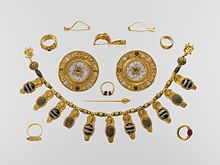



Unfortunately the classical era was a period of crisis for the Etruscans. During the 5th century, Etruscan jewelry suffers a regression. Such techniques as filigree and granulation gradually disappeared. Others, like repoussé are used to decorate thin funerary bands, necklaces and lockets (or bullae). During this period, a different kind of earring comes into fashion: the grape cluster shaped earring. These kinds of earrings would cover the whole ear and sometimes hung down to the neck.
During the archaic period, "bigger was better". Large hanging earrings, long necklaces and heavy pendants or bullae were in style and worn by both men and woman alike. Women were heavily adorned and wore large diadems, bracelets and circlets, hair spirals, heavy earrings in the shape of grape clusters, large heavy pendants (also worn by men and children).
These were the fashion all throughout the 5th and 4th centuries. Necklaces were paired up. They would wear big necklaces with assorted beads, then another one with a big hanging pendant. Earrings with a long oval pendant and a smaller one hanging below were also very well received in the Etruscan community. In the early 3rd century, bead necklaces and bullae remain popular as do torcs, which were rings of color hair (of an animal) or feathers around the neck. In the late classical era body jewelry became more and more popular as the fashions tended towards a progressive state of undress. The body jewelry was the adornment of the body and was paired with other artifacts such as shoes, holding mirrors, etc.
These styles stayed popular throughout the Hellenistic period as well as the Roman period. During the Hellenistic periods, technical decline and excessively complex shapes and decoration characterized the jewelry.
Jewelry becomes omnipresent during the Hellenistic period. It becomes unisex and is worn by people whether they are naked or dressed. In images, women were often represented with only slippers and a torque or necklace. The heavy necklaces of the classical era are now replaced by strands of beads and torques.

Jewellery consists of decorative items worn for personal adornment such as brooches, rings, necklaces, earrings, pendants, bracelets, and cufflinks. Jewellery may be attached to the body or the clothes. From a western perspective, the term is restricted to durable ornaments, excluding flowers for example. For many centuries metal such as gold often combined with gemstones, has been the normal material for jewellery, but other materials such as glass, shells and other plant materials may be used.
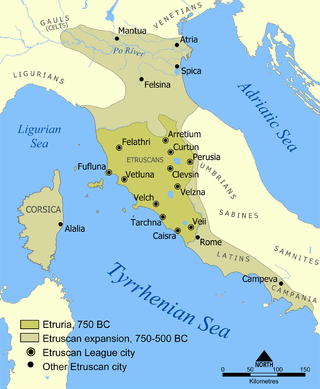
The Etruscan civilization was an ancient civilization created by the Etruscans, a people who inhabited Etruria in ancient Italy, with a common language and culture who formed a federation of city-states. After conquering adjacent lands, its territory covered, at its greatest extent, roughly what is now Tuscany, western Umbria, and northern Lazio, as well as what are now the Po Valley, Emilia-Romagna, south-eastern Lombardy, southern Veneto, and western Campania.
Etruria was a region of Central Italy delimited by the rivers Arno and Tiber, an area that covered what is now most of Tuscany, northern Lazio, and north-western Umbria. It was inhabited by the Etruscans, an ancient civilization that flourished in the area from around the 8th century BC until they were assimilated into the Roman Republic in the 4th century BC.

A necklace is an article of jewellery that is worn around the neck. Necklaces may have been one of the earliest types of adornment worn by humans. They often serve ceremonial, religious, magical, or funerary purposes and are also used as symbols of wealth and status, given that they are commonly made of precious metals and stones.

A brooch is a decorative jewellery item designed to be attached to garments, often to fasten them together. It is usually made of metal, often silver or gold or some other material. Brooches are frequently decorated with enamel or with gemstones and may be solely for ornament or serve a practical function as a clothes fastener. The earliest known brooches are from the Bronze Age. As fashions in brooches changed rather quickly, they are important chronological indicators. In archaeology, ancient European brooches are usually referred to by the Latin term fibula. One example is the Tara Brooch

Filigree is a form of intricate metalwork used in jewellery and other small forms of metalwork.
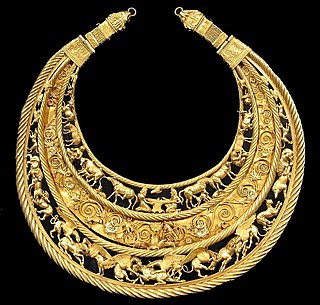
Jewellery as an art form originated as an expression of human culture. Body ornamentation, one purpose of jewellery, has been known since at least the Stone Age. The history of jewellery in Ukraine reflects the influence of many cultures and peoples who have occupied the territory in the past and present.

Bucchero is a class of ceramics produced in central Italy by the region's pre-Roman Etruscan population. This Italian word is derived from the Latin poculum, a drinking-vessel, perhaps through the Spanish búcaro, or the Portuguese púcaro.
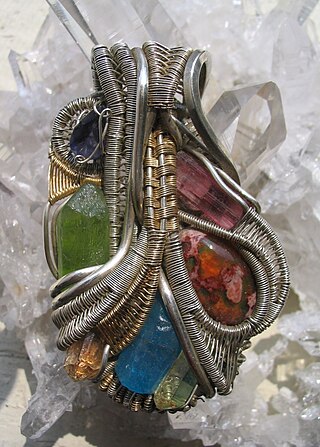
Wire wrapping is one of the oldest techniques for making handmade jewelry. This technique is done with jewelry wire and findings similar to wire to make components. Wire components are then connected to one another using mechanical techniques with no soldering or heating of the wire. Frequently, in this approach, a wire is bent into a loop or other decorative shape and then the wire is wrapped around itself to finish the wire component. This makes the loop or decorative shape permanent. The technique of wrapping wire around itself gives this craft its name of wire wrapping.

Etruscan art was produced by the Etruscan civilization in central Italy between the 10th and 1st centuries BC. From around 750 BC it was heavily influenced by Greek art, which was imported by the Etruscans, but always retained distinct characteristics. Particularly strong in this tradition were figurative sculpture in terracotta, wall-painting and metalworking especially in bronze. Jewellery and engraved gems of high quality were produced.
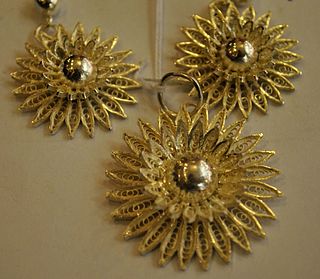
Tarakasi is a type of silver filigree work from Cuttack, a city in Odisha in the eastern part of India.

Native American jewelry refers to items of personal adornment, whether for personal use, sale or as art; examples of which include necklaces, earrings, bracelets, rings and pins, as well as ketohs, wampum, and labrets, made by one of the Indigenous peoples of the United States. Native American jewelry normally reflects the cultural diversity and history of its makers, but tribal groups have often borrowed and copied designs and methods from other, neighboring tribes or nations with which they had trade, and this practice continues today. Native American tribes continue to develop distinct aesthetics rooted in their personal artistic visions and cultural traditions. Artists may create jewelry for adornment, ceremonies, and display, or for sale or trade. Lois Sherr Dubin writes, "[i]n the absence of written languages, adornment became an important element of Indian communication, conveying many levels of information." Later, jewelry and personal adornment "...signaled resistance to assimilation. It remains a major statement of tribal and individual identity."

The Middle Ages was a period that spanned approximately 1000 years and is normally restricted to Europe and the Byzantine Empire. The material remains we have from that time, including jewelry, can vary greatly depending on the place and time of their creation, especially as Christianity discouraged the burial of jewelry as grave goods, except for royalty and important clerics, who were often buried in their best clothes and wearing jewels. The main material used for jewelry design in antiquity and leading into the Middle Ages was gold. Many different techniques were used to create working surfaces and add decoration to those surfaces to produce the jewelry, including soldering, plating and gilding, repoussé, chasing, inlay, enameling, filigree and granulation, stamping, striking and casting. Major stylistic phases include barbarian, Byzantine, Carolingian and Ottonian, Viking, and the Late Middle Ages, when Western European styles became relatively similar.

Traditional metal working in Mexico dates from the Mesoamerican period with metals such as gold, silver and copper. Other metals were mined and worked starting in the colonial period. The working of gold and silver, especially for jewelry, initially declined after the Spanish conquest of the Aztec Empire. However, during the colonial period, the working of metals rose again and took on much of the character traditional goods still have. Today, important metal products include those from silver, gold, copper, iron, tin and more made into jewelry, household objects, furniture, pots, decorative objects, toys and more. Important metal working centers include Taxco for silver, Santa Clara del Cobre for copper, Celaya for tin and Zacatecas for wrought iron.

Granulation is a jewellery manufacturing technique whereby a surface is covered in spherules or granules of precious metal. The technique is thought to have its origins in Sumer about 5,000 years ago. This technique then spread to southern Europe during the orientalizing period, also through the role of Phoenicians, who had founded colonies in Sardinia, Sicily and Spain, or Near Eastern craftsmen.

Ancient Roman jewelry was characterized by an interest in colored gemstones and glass, in contrast with their Greek predecessors who focused primarily on the production of high-quality metalwork by practiced artisans. Extensive control of Mediterranean territories provided an abundance of natural resources to utilize in jewelry making. Participation in trade allowed access to both semi-precious and precious stones that traveled down the Persian Silk Road from the East.

Set of jewelry, also known as the Vulci group is a set of 5th century BCE Etruscan metalwork collection by an unknown jeweler. It is in the collection of the Metropolitan Museum of Art.

Yemenite silversmithing refers to the work of Jewish silversmiths from Yemen. They were highly acclaimed craftsmen who dominated craft production in precious metals in the southern Arabian peninsula from at least the 18th through the mid-20th century, a period and region during which Muslims did not engage in this work. These Yemenite silversmiths were noted for their skilled use of fine granulation and filigree, producing ornaments such as women's bracelets, necklaces, finials, as well as elaborate scabbard sheaths for men's daggers.
The Castellani were a family of goldsmiths, collectors, antique dealers and potters who created a business "empire" active in Rome during the 18th and 19th centuries.

Women were respected in Etruscan society compared to their ancient Greek and Roman counterparts. Today only the status of aristocratic women is known because no documentation survives about women in other social classes.